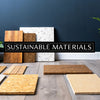7 Sustainable Interior Design Ideas for 2025

Creating Eco-Conscious Spaces
Want a stylish home that's also kind to the planet? This list of sustainable interior design ideas offers practical solutions for eco-conscious homeowners, designers, and businesses across New Zealand and Australia. Discover how incorporating elements like reclaimed materials, energy-efficient lighting, and sustainable wood can minimize your environmental impact without compromising aesthetics. Learn how to create beautiful, healthy spaces using low-VOC paints, biophilic design, recycled textiles, and water-efficient fixtures. These sustainable interior design ideas will help you build a more environmentally friendly home or business.
1. Reclaimed and Upcycled Materials
One of the most impactful sustainable interior design ideas is incorporating reclaimed and upcycled materials. This approach involves sourcing and repurposing existing materials, diverting them from landfill and giving them a new lease on life within your interior spaces. From structural elements like flooring and beams to decorative pieces like furniture and lighting, the possibilities are vast and offer a unique way to achieve both aesthetically pleasing and environmentally responsible design. This method not only minimises your environmental footprint but also infuses spaces with character, history, and a distinct sense of individuality that mass-produced items simply can't replicate. It's a core principle of circular economy practices, promoting resource efficiency and reducing the demand for virgin materials.
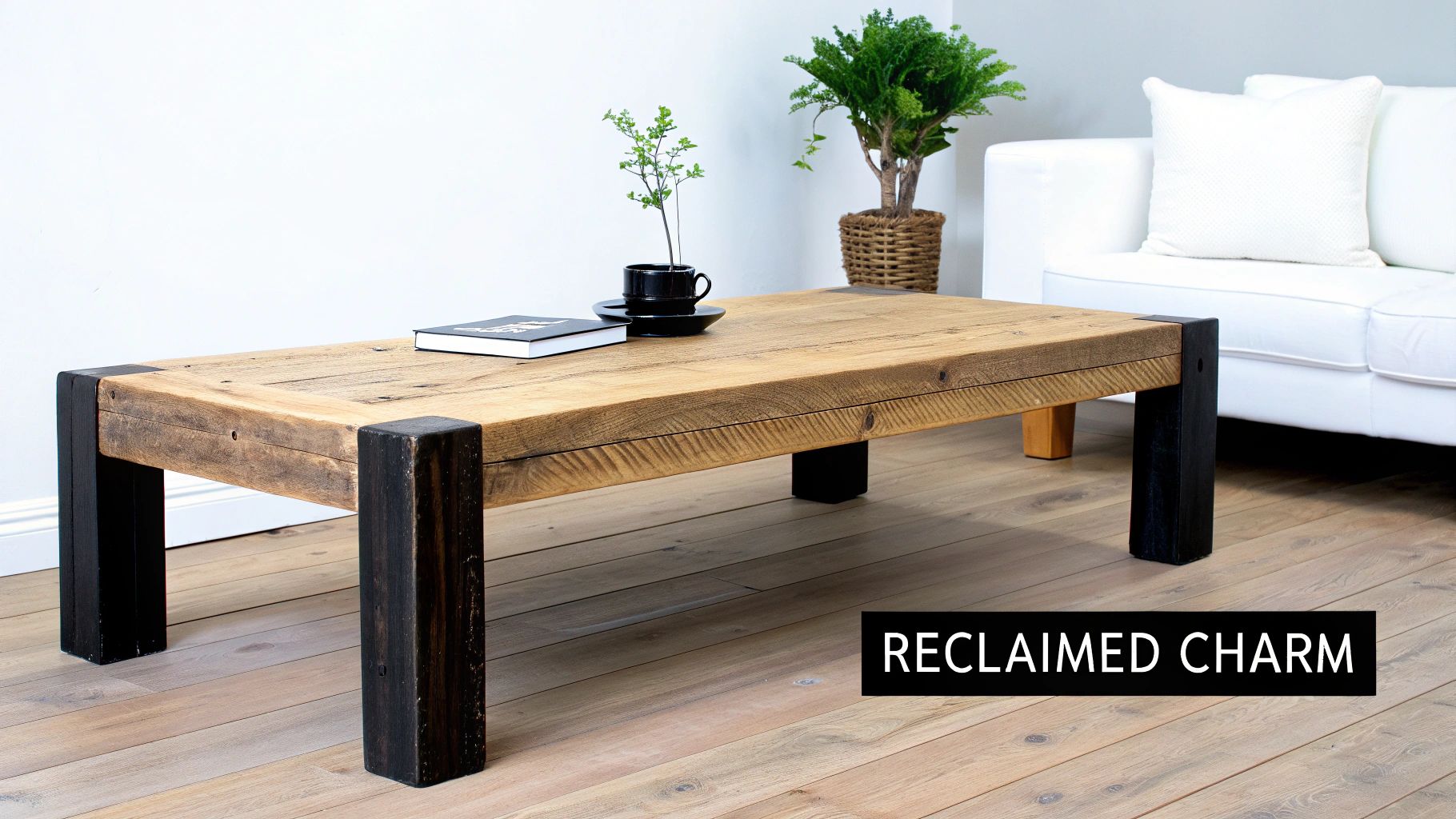
Reclaimed materials often boast a unique patina and character developed over time, adding a sense of authenticity and storytelling to your space. Think exposed brick walls from a demolished Auckland warehouse, repurposed rimu floorboards from a villa renovation, or vintage industrial lighting fixtures salvaged from a Christchurch factory. These materials carry the echoes of their past, imbuing your interiors with a depth and richness that new materials can't replicate. Moreover, many older materials, especially timber, were crafted with superior techniques and durability, offering longevity and resilience. For homeowners in New Zealand and Australia who appreciate the charm of heritage and character homes, integrating reclaimed elements can enhance these qualities while aligning with sustainable practices.
The benefits of using reclaimed and upcycled materials extend beyond aesthetics. By reducing the demand for newly manufactured products, you significantly lessen the environmental impact associated with resource extraction, processing, and transportation. Often, reclaimed materials are also more cost-effective than their brand-new counterparts, making sustainable design accessible to a wider range of budgets. This is particularly appealing to DIY home decorators and craft enthusiasts who can find unique and affordable materials for their projects.
There are numerous ways to implement this sustainable interior design idea in both residential and commercial settings. Consider using reclaimed timber for flooring, wall cladding, or creating bespoke furniture pieces. Vintage fixtures, like lighting and hardware, can add a touch of industrial chic or timeless elegance. For example, a café in Wellington could use reclaimed wood for tabletops and bar counters, contributing to a unique and eco-conscious brand identity. Similarly, commercial property developers in Auckland can incorporate salvaged brick or steel in new builds, adding an element of history and sustainability to modern spaces.
While the benefits are compelling, it's crucial to be aware of the potential challenges associated with reclaimed materials. Sourcing appropriate materials can be time-consuming, requiring research and visits to architectural salvage yards, demolition sites, or online marketplaces. Inspecting materials thoroughly for structural integrity and potential safety concerns, like lead paint or asbestos, is paramount. For vintage electrical fixtures, consulting a qualified electrician for proper installation is essential. In some cases, materials may require additional treatment or restoration work, which can add to the overall project cost and timeline.
To successfully incorporate reclaimed and upcycled materials into your design, consider these tips:
- Thorough Inspection: Carefully inspect all salvaged materials for structural soundness, pest infestations, and potential hazards like lead paint or asbestos.
- Local Sourcing: Explore local architectural salvage yards, demolition companies, and online marketplaces like Trade Me for unique finds within your region. This reduces transportation costs and supports local businesses.
- Professional Consultation: For complex installations or restoration work, consider hiring specialists. A qualified electrician should handle vintage lighting fixtures, while experienced carpenters can work with reclaimed timber.
- Documentation: Document the history and origin of the materials whenever possible. This adds to their storytelling value and creates a deeper connection with the space.
The trend of incorporating reclaimed and upcycled materials has been popularized by figures like Joanna Gaines, known for her farmhouse aesthetic featuring repurposed elements, and brands like Restoration Hardware and West Elm, which offer collections incorporating reclaimed wood and vintage-inspired designs. Design firms like Brooklyn-based Fort Standard have also championed the use of salvaged materials, showcasing their potential for creating contemporary and sustainable design. By thoughtfully integrating these materials, you can create interiors that are not only beautiful and functional but also contribute to a more sustainable future, resonating with the growing eco-conscious community in New Zealand and Australia.
2. Low-VOC and Natural Paints
Creating a truly sustainable interior goes beyond aesthetics and delves into the very air we breathe within our homes and workspaces. One of the most impactful ways to achieve this is by choosing low-VOC and natural paints. Conventional paints often release volatile organic compounds (VOCs) – harmful chemicals that can negatively impact indoor air quality and contribute to a range of health problems, from headaches and eye irritation to more serious respiratory issues. Switching to low-VOC or natural paint alternatives dramatically reduces or eliminates these risks, fostering a healthier environment for you, your family, and the planet. This makes them an essential element of any sustainable interior design project.
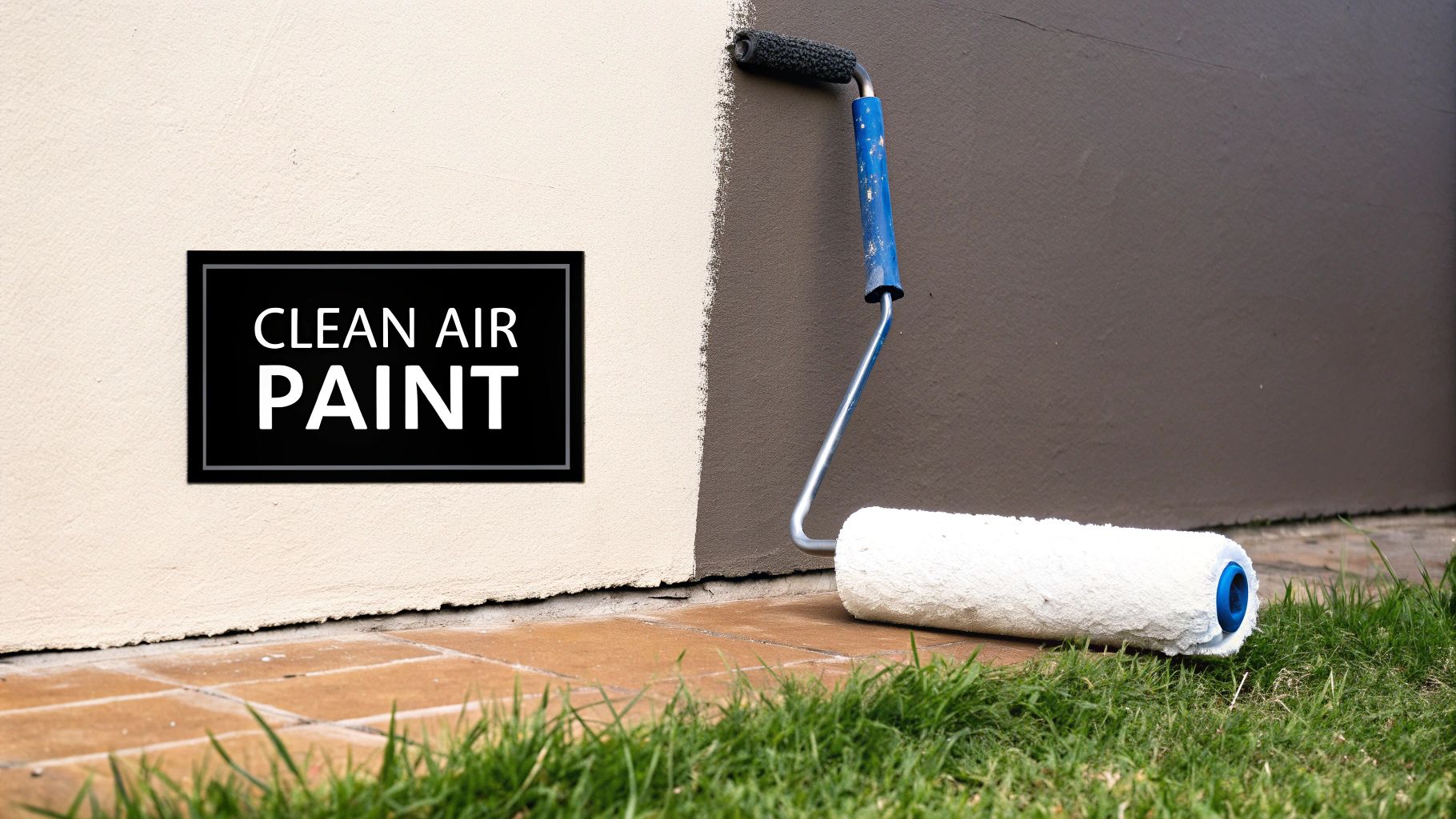
Low-VOC paints contain minimal amounts of VOCs (under 50g/L), while natural paints go a step further by utilizing ingredients derived from nature. These include clay, lime, casein (milk protein), and plant-based oils and pigments. These paints are biodegradable and non-toxic, minimizing their environmental impact. Contrary to popular belief, natural paints now offer a vibrant full spectrum of colours achieved through natural pigments, allowing for beautiful and healthy interiors. This shift towards healthier interiors aligns perfectly with the growing eco-conscious movement in New Zealand and Australia, where homeowners are increasingly seeking sustainable and healthy building materials.
The benefits of choosing low-VOC and natural paints are significant. Improved indoor air quality is the most prominent advantage, creating a healthier living or working space, especially beneficial for children, pets, and individuals with chemical sensitivities. The absence of off-gassing and strong chemical odours makes decorating a more pleasant experience. Many natural paints also possess inherent antimicrobial and mold-resistant properties, contributing to a cleaner and healthier environment, particularly valuable in the sometimes humid climate of New Zealand. Furthermore, opting for these paints supports sustainable practices and reduces your contribution to harmful chemical emissions.
Examples of successful implementation are abundant, demonstrating the growing popularity of these paints. Globally, companies like Google (using Benjamin Moore Natura paint), IKEA (switching to water-based, low-VOC paints), and Whole Foods Market (using clay-based paints) have adopted these sustainable alternatives. Renowned designers like Kelly Wearstler have showcased the beauty of lime wash finishes in residential projects. Within New Zealand and Australia, an increasing number of architects and designers are specifying these paints for both residential and commercial projects, reflecting a growing commitment to sustainable design.
While low-VOC and natural paints offer significant advantages, it's important to be aware of their limitations. They generally come with a higher price tag than conventional paints (typically 20-40% more). They may also require more frequent touch-ups or reapplication depending on the type of paint and the environment. Availability can be limited in some regions, though this is rapidly improving with growing demand. While the colour palette has expanded significantly, some highly specialized colours might be more readily available in conventional paints.
Here are some helpful tips for using low-VOC and natural paints:
- Allow extra drying time: Especially in humid conditions, natural paints can take longer to dry.
- Use high-quality brushes and rollers: These will ensure the best application and finish.
- Test colours in different lighting conditions: Natural light can significantly affect how a colour appears.
- Store leftover paint properly: Natural paints may have a shorter shelf life than conventional paints, so proper storage is essential.
Popular brands offering low-VOC and natural paint options include Benjamin Moore (Natura line), Sherwin Williams (ProMar 200 Zero VOC), and specialist brands like Clare Paint and Farrow & Ball. Local suppliers in New Zealand are also increasingly stocking these eco-friendly alternatives. Consider incorporating low-VOC and natural paints in your next interior design project to create beautiful, healthy, and sustainable spaces. Whether you are renovating your home, designing a commercial space, or simply refreshing a room, choosing low-VOC and natural paints contributes positively to both your well-being and the environment. This commitment to sustainable interior design ideas creates lasting value and contributes to a healthier future for all.
3. Energy-Efficient LED Lighting Systems
In the pursuit of sustainable interior design, lighting plays a crucial role. Energy-efficient LED lighting systems stand out as a transformative solution, offering significant environmental and economic benefits. These advanced systems combine the latest LED technology with smart controls, natural light integration, and human-centric lighting principles to create spaces that are both beautiful and responsible. This approach not only drastically reduces energy consumption – by 75-80% compared to traditional lighting – but also enhances light quality and offers a significantly longer lifespan. By switching to LEDs, you're making a substantial contribution to a greener future and enjoying significant long-term savings. This makes LED lighting a cornerstone of sustainable interior design, especially relevant for eco-conscious homeowners and businesses in New Zealand and Australia.
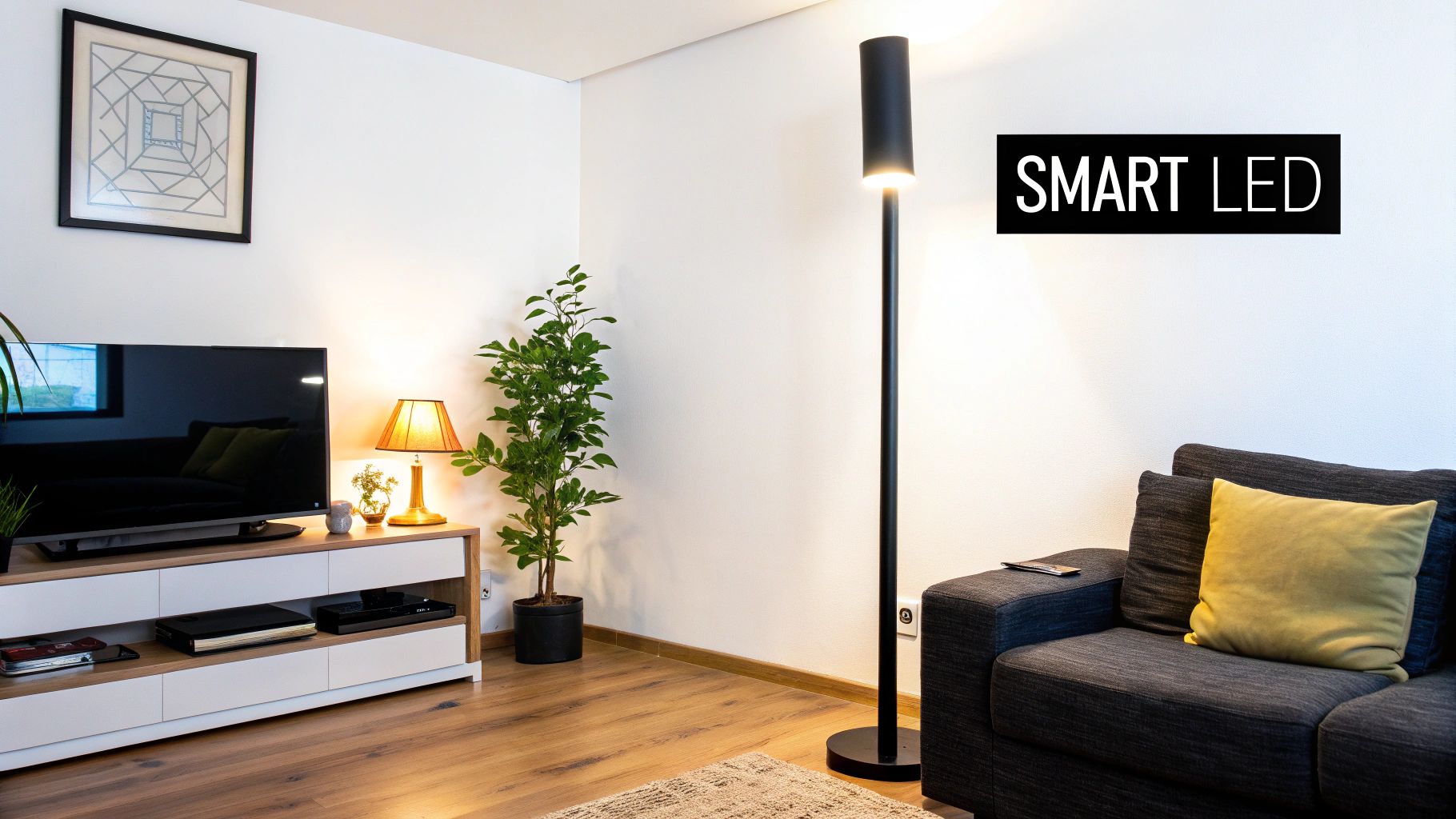
LED lighting systems work by using a semiconductor to convert electricity into light. Unlike incandescent bulbs, which produce light through heat, LEDs generate very little heat, making them incredibly energy efficient. Coupled with smart controls, these systems can be optimized for peak performance. Daylight sensors can detect ambient light levels and automatically adjust the artificial lighting, minimizing unnecessary energy use. Integration with smart home systems allows for further customization, including scheduling, scene setting, and remote control via smartphones or tablets. This level of control empowers users to personalize their lighting experience while maximizing energy savings.
Several impressive examples demonstrate the successful implementation of energy-efficient LED lighting. Apple Park headquarters utilizes circadian rhythm lighting, adjusting the colour temperature throughout the day to mimic natural light patterns and promote employee well-being. Closer to home, the Philips Hue smart lighting system provides homeowners in NZ and Australia with a user-friendly platform for customized residential lighting. On a larger scale, Tesla's Gigafactory employs LED high-bay lighting throughout its massive facility, showcasing the technology's effectiveness in industrial settings. The Edge building in Amsterdam takes it even further with personalized LED lighting, allowing occupants to adjust their workspace lighting according to their preferences.
For homeowners, interior designers, and architects in New Zealand and Australia looking to implement sustainable lighting solutions, here are some practical tips:
- Choose LEDs with a high CRI (Colour Rendering Index): CRI measures how accurately a light source renders colours compared to natural light. A higher CRI (90 or above) ensures that colours appear vibrant and true-to-life.
- Install dimmer switches: Dimming LEDs not only creates ambiance but also further reduces energy consumption. Dimmer compatibility should be confirmed when purchasing LED bulbs.
- Consider circadian lighting: Mimicking the natural cycle of daylight can positively impact sleep patterns and overall well-being. Several LED systems offer tunable white light, allowing you to adjust the colour temperature throughout the day.
- Use daylight sensors: Automate your lighting by integrating daylight sensors that adjust artificial light levels based on the available natural light, maximizing energy efficiency.
While the benefits of LED lighting systems are undeniable, it's essential to consider the potential drawbacks:
- Higher upfront investment costs: LEDs typically have a higher initial cost than traditional bulbs. However, the long-term energy savings and extended lifespan more than compensate for the upfront investment.
- Blue light content: Excessive exposure to blue light emitted by some LEDs can disrupt sleep patterns. Choose LEDs with warmer colour temperatures for evening use or utilize features that reduce blue light emission.
- Quality variations: The quality of LEDs varies significantly between manufacturers. Opt for reputable brands and look for certifications like Energy Star to ensure quality and performance.
- Complex smart systems: Sophisticated smart lighting systems may require professional installation, adding to the initial cost.
LED lighting systems are an essential component of sustainable interior design, offering a powerful way to reduce energy consumption, enhance light quality, and contribute to a greener future. From residential applications to large-scale commercial projects, the benefits of LED technology are transforming the way we light our spaces. For those in New Zealand and Australia, embracing this technology is not just a design choice, but a step towards a more sustainable and energy-efficient future. By understanding the features, benefits, and potential drawbacks, you can make informed decisions when incorporating LED lighting into your next project, whether it's a new build, renovation, or simply upgrading existing lighting fixtures.
4. Sustainable and Certified Wood Products
Incorporating sustainable and certified wood products into your interior design is a powerful way to minimize your environmental footprint while creating beautiful, long-lasting spaces. This approach focuses on utilizing wood materials sourced from responsibly managed forests, ensuring that the wood you choose contributes to the health of our planet rather than its depletion. By opting for certified wood, you support forest ecosystems, biodiversity, and the livelihoods of communities that depend on them. This makes it a crucial element of any sustainable interior design plan, particularly in environmentally conscious regions like New Zealand and Australia.
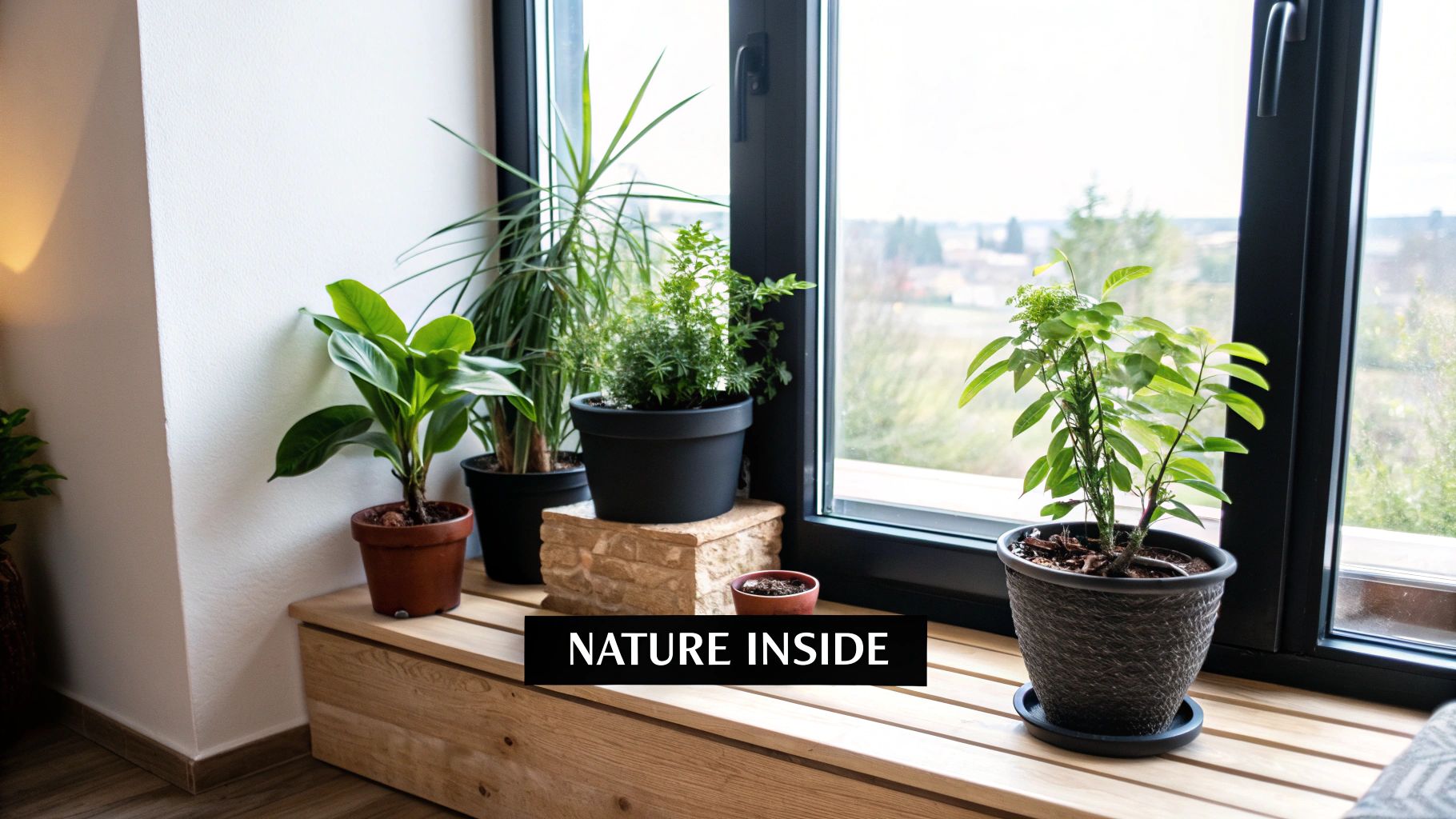
This method works through a system of third-party certifications, such as the Forest Stewardship Council (FSC) and the Programme for the Endorsement of Forest Certification (PEFC). These organizations establish rigorous standards for responsible forest management, encompassing environmental protection, social responsibility, and economic viability. A "chain of custody" system tracks the wood from the forest to the finished product, ensuring that certified materials are used throughout the production process. This transparency allows consumers to make informed choices and support sustainable practices. From flooring and furniture to cabinetry and architectural elements, a wide range of certified wood products are available, offering a renewable and biodegradable alternative to less sustainable materials. Furthermore, during the tree's growth cycle, carbon is sequestered, further contributing to the mitigation of climate change.
Several international and local companies champion sustainable wood sourcing. IKEA, for instance, has committed to using 100% FSC-certified wood. West Elm also features sustainably sourced furniture collections. Closer to home, many New Zealand timber suppliers are committed to FSC certification, making it increasingly accessible for local projects. Examples of successful implementation can be seen in various settings, from Google's offices featuring FSC-certified wood to Patagonia's retail stores utilizing locally sourced, certified timber. These businesses demonstrate that sustainability and style can go hand in hand.
Here are some actionable tips to help you incorporate sustainable and certified wood into your next project:
- Verify certification labels: Look for the FSC or PEFC logos and ask for documentation to ensure authenticity.
- Prioritize local sourcing: Choosing locally sourced species, such as sustainably harvested New Zealand timbers like rimu, matai, and totara (when available and appropriate), reduces transportation impacts and supports local economies.
- Consider recycled wood: Explore the use of reclaimed or recycled wood for a unique and eco-friendly option. Many NZ businesses specialize in repurposing timber.
- Opt for low-VOC finishes: Use water-based, low-VOC (volatile organic compound) finishes to maintain the sustainability of your wood products and improve indoor air quality.
- Explore bamboo: Consider bamboo as a rapidly renewable alternative to traditional hardwoods, especially for flooring and cabinetry.
- Maintain your wood: Proper maintenance and care, including regular cleaning and sealing, will extend the lifespan of your wood products, maximizing their value and minimizing the need for replacements.
Sustainable and certified wood products deserve a prominent place in any sustainable interior design strategy for numerous reasons. They support responsible forestry practices, offer a renewable resource, and add natural beauty and warmth to interiors. The inherent durability of wood also contributes to its longevity, making it a cost-effective choice in the long run. While certified products might initially cost 10-15% more, this premium represents an investment in environmental stewardship and responsible consumption. The limited availability of certain species, depending on the region, and the ongoing maintenance requirements are factors to consider. However, the environmental and social benefits far outweigh these limitations, especially for eco-conscious consumers and businesses in New Zealand and Australia. By making informed choices and embracing certified wood, you can create spaces that are both beautiful and responsible, reflecting a commitment to a healthier planet.
5. Indoor Plants and Biophilic Design
Bringing the outdoors in is more than just a fleeting trend; it’s a fundamental shift towards creating healthier, more sustainable, and aesthetically pleasing interior spaces. Indoor plants and biophilic design represent a powerful sustainable interior design idea, offering a multitude of benefits for both the environment and the occupants of a space. This approach focuses on integrating living plants and natural elements into interior spaces to improve air quality, enhance well-being, and foster a deeper connection with nature. By incorporating elements of the natural world, you can transform your home or workspace into a sanctuary that promotes both physical and mental well-being.
Biophilic design, a term popularized by biologist E.O. Wilson, recognizes the innate human affinity for nature. It seeks to satisfy this inherent need by incorporating natural forms, patterns, and processes into the built environment. This can manifest in various ways, from using natural materials like timber and stone to incorporating natural light and ventilation, and, of course, integrating living greenery. Think of it as weaving the restorative power of nature into the fabric of your home or office.
One of the key features of incorporating plants is their NASA-verified air purification capabilities. Certain plants, such as snake plants, spider plants, and peace lilies, are remarkably effective at filtering out common indoor air toxins like formaldehyde and benzene, leading to significantly improved indoor air quality. Beyond air purification, plants also contribute to natural humidity regulation, reducing the need for mechanical humidifiers and creating a more comfortable and healthy indoor environment, particularly important during dry New Zealand winters.
The psychological and physiological health benefits are equally compelling. Studies have shown that exposure to nature, even in an indoor setting, can reduce stress, improve mental well-being, and enhance creativity and productivity. Imagine working in an office filled with lush greenery, or relaxing in a living room adorned with vibrant plants – the positive impact on mood and focus is undeniable. For businesses in New Zealand and Australia, incorporating biophilic design can create a more inviting and productive work environment, potentially boosting employee morale and attracting top talent.
Examples of successful biophilic design implementations abound, demonstrating its effectiveness on a large scale. The Amazon Spheres in Seattle, featuring an astounding 40,000 plants, showcase the transformative potential of indoor greenery. Singapore's Changi Airport, renowned for its breathtaking indoor gardens, offers a tranquil oasis for travellers. Even tech giants like Google have embraced biophilic design principles in their offices worldwide, recognizing the benefits for employee well-being and creativity. Closer to home, the 1 Hotels chain champions sustainability with living walls and extensive plant installations in their properties.
While the advantages are numerous, it’s important to consider the practical aspects. Indoor plants require ongoing care and maintenance, including watering, fertilizing, and occasional repotting. Potential pest issues can arise if plants are not properly managed. Additionally, some individuals may have allergies to certain plants. More complex installations, such as living walls, typically require professional installation and maintenance.
To get started with incorporating indoor plants and biophilic design in your own space, consider these practical tips:
- Choose low-maintenance, air-purifying plants: Snake plants, pothos, and ZZ plants are excellent choices for beginners.
- Group plants with similar care requirements together: This simplifies watering and maintenance.
- Use self-watering systems: These systems can make plant care much easier, especially for busy individuals.
- Incorporate natural materials: Complement your plants with natural materials like stone, wood, and water features to further enhance the biophilic aesthetic.
- Consider the light levels in your space: Choose plants that are suited to the available light.
Learn more about Indoor Plants and Biophilic Design
By thoughtfully incorporating plants and natural elements, you can create spaces that are not only visually appealing but also contribute to a healthier, more sustainable lifestyle. Whether you’re a homeowner looking to refresh your living space, a business owner seeking to improve your work environment, or a designer exploring sustainable interior design ideas, biophilic design offers a powerful and versatile approach to creating spaces that nurture both people and the planet. For those in New Zealand specifically, embracing biophilic design can be a beautiful way to connect with the country's renowned natural beauty, bringing a touch of the outdoors into the heart of your home or workspace.
6. Eco-Friendly and Recycled Textiles
Sustainable interior design goes far beyond aesthetics; it considers the entire lifecycle of the materials used in our spaces. One of the most impactful ways to embrace sustainability in your home or business is through the conscious selection of eco-friendly and recycled textiles. This encompasses everything from upholstery and curtains to rugs, bedding, and even decorative cushions. By opting for sustainable fabrics and soft furnishings, you contribute to a healthier planet and create a more mindful living environment.
These textiles differentiate themselves from conventional options through their responsible sourcing, production, and end-of-life considerations. They are made from materials like organic cotton, hemp, recycled polyester, or innovative bio-based fibers. This approach minimizes environmental impact by reducing reliance on resource-intensive virgin materials and diverting waste from landfills. Furthermore, the processing of these textiles prioritizes non-toxic methods, minimizing chemical pollution and excessive water usage often associated with conventional textile production.
For instance, Patagonia, a global leader in sustainable apparel, utilizes recycled polyester derived from plastic bottles to create their durable and popular fleece fabrics. This exemplifies the circular economy in action, transforming waste into a valuable resource. Closer to home, companies like West Elm offer organic cotton and linen bedding collections, providing beautiful and sustainable choices for New Zealand consumers. Even in the commercial realm, Herman Miller integrates recycled plastic textiles into their iconic office chairs, proving that sustainability can seamlessly blend with high-performance design. Fashion designer Stella McCartney and Eileen Fisher, known for their ethical fashion practices, champion organic cotton and Tencel in their clothing lines, showcasing the versatility and aesthetic appeal of these materials. These examples demonstrate how leading brands prioritize sustainability without compromising on quality or style.
There are several compelling reasons to embrace eco-friendly and recycled textiles in your interior design projects. These fabrics offer numerous advantages, including reduced water consumption and chemical pollution during production. Choosing organic materials supports sustainable farming practices that improve soil health and biodiversity. Furthermore, these textiles often exhibit superior durability and longevity compared to their conventional counterparts, making them a worthwhile investment. An added benefit is that they are often naturally antimicrobial and hypoallergenic, making them a healthier choice for those with sensitive skin or allergies. This is especially beneficial in the often humid climate of New Zealand, where dust mites can be a concern.
While the benefits are significant, there are some considerations to keep in mind. Eco-friendly and recycled textiles are generally 25-50% more expensive than conventional options, reflecting the higher production costs associated with ethical sourcing and processing. Additionally, the color and pattern options might be more limited in certain categories, although this is continually improving as the market expands. Some materials may require specific care instructions to maintain their quality, so be sure to check the manufacturer's recommendations. Finally, availability can be limited in certain regions, although online retailers are increasingly bridging this gap.
For those keen to incorporate sustainable textiles into their homes or businesses, here are some actionable tips: Look for certifications like GOTS (Global Organic Textile Standard), OEKO-TEX (which certifies textiles free of harmful substances), or Cradle to Cradle, which assesses a product’s entire lifecycle for environmental and social responsibility. When choosing rugs, opt for natural fibers like jute or sisal, which can be composted at the end of their life. Prioritize investing in high-quality, durable pieces that will last longer, reducing the need for frequent replacements. Finally, care for your textiles properly, following washing and drying instructions, to extend their lifespan and maximize your investment.
Learn more about Eco-Friendly and Recycled Textiles specifically focusing on the benefits of linen. This versatile fabric is an excellent example of a sustainable choice readily available in New Zealand.
By embracing eco-friendly and recycled textiles, you not only contribute to a more sustainable future but also create a healthier and more ethically conscious living or working space. Whether you're renovating your entire home, refreshing a single room, or simply updating your cushion covers, consider the impact of your choices and opt for textiles that align with your values. This seemingly small decision can have a significant positive impact on the environment and contribute to a more sustainable interior design landscape in New Zealand and beyond.
7. Water-Efficient Fixtures and Appliances
Water is a precious resource, and incorporating water-efficient fixtures and appliances is a crucial step towards creating truly sustainable interior design. This approach minimizes water consumption without compromising performance, contributing to both environmental and economic benefits. For environmentally conscious homeowners, interior designers, and architects in New Zealand and Australia, embracing water efficiency is not just a trend – it's a responsibility. This section explores how incorporating water-efficient fixtures and appliances can significantly contribute to sustainable interior design ideas.
How Water Efficiency Works in Your Home
Water-efficient fixtures and appliances achieve their goal through innovative design and technology. Low-flow toilets, for example, utilize optimized bowl shapes and flushing mechanisms to use less water per flush, often employing dual-flush systems that allow for different water volumes depending on the need. Efficient showerheads restrict water flow while maintaining water pressure through features like aerators, which mix air with the water stream. Smart irrigation systems monitor weather conditions and soil moisture levels, delivering only the necessary amount of water to your garden, eliminating wasteful runoff. ENERGY STAR appliances, such as washing machines and dishwashers, are designed to use less water per cycle, further reducing your overall consumption.
Examples of Successful Implementation
Leading manufacturers like Kohler, Delta Faucet, and Moen have spearheaded the development of water-efficient technologies. Kohler's smart toilets, for example, feature efficient dual-flush systems and even integrate with home automation systems for usage monitoring. Delta's touch-free faucets not only offer convenience but also reduce water waste by automatically shutting off the flow when not in use. Moen's smart shower systems track water usage, allowing you to monitor and adjust your habits. Moreover, California’s mandatory low-flow fixture requirements serve as a testament to the efficacy and growing adoption of these technologies. While not mandatory in NZ or Australia yet, these examples demonstrate the potential for significant water savings.
Actionable Tips for Implementing Water Efficiency
- Look for WaterSense certified products: WaterSense is a program similar to ENERGY STAR but specifically for water efficiency. Products with this label meet rigorous performance and efficiency criteria.
- Install smart leak detectors: These devices can identify even small leaks, preventing significant water waste and potential damage to your property.
- Consider greywater systems: Greywater systems collect and reuse water from showers, sinks, and washing machines for landscape irrigation, reducing reliance on fresh water. This is particularly beneficial in drier regions of Australia and New Zealand.
- Regular maintenance: Ensure optimal efficiency by regularly checking for leaks, cleaning aerators, and descaling showerheads.
Why and When to Implement Water-Efficient Fixtures
Water-efficient fixtures and appliances are relevant to any renovation project, new build, or even simply upgrading existing fixtures. Whether you are an eco-conscious homeowner, a commercial property developer, or running a hospitality business, reducing water consumption is both environmentally responsible and financially sound. Implementing these changes reduces your impact on municipal water systems, especially crucial in drought-prone areas of Australia and New Zealand.
Pros and Cons of Water-Efficient Fixtures
Pros:
- Reduced water bills: Expect to see a decrease in your water bills by 20-40% annually.
- Decreased strain on municipal water systems: Contributes to a more sustainable water future for your community.
- Reduced energy costs for water heating: Less hot water usage translates to lower energy bills.
- Potential for rebates and incentives: Many local councils in NZ and Australia offer rebates and incentives for installing water-efficient fixtures.
Cons:
- Higher upfront costs: Premium efficient models can have a higher initial cost compared to standard fixtures.
- Potential performance issues (mostly outdated): While earlier low-flow toilets sometimes had performance issues, modern technology has addressed these concerns.
- May require adjusting usage habits: Adapting to new flow rates might require minor adjustments in showering or washing habits.
- Smart system maintenance: Complex smart systems may require professional maintenance.
Incorporating water-efficient fixtures and appliances is a fundamental component of sustainable interior design. It’s a practical step that offers both tangible and long-term benefits, making it a must-consider for any project aiming to minimize environmental impact and promote responsible resource management. From small changes like swapping showerheads to larger investments like smart toilets, every effort contributes to a more sustainable future, particularly relevant in the context of New Zealand and Australia's unique water challenges.
Sustainable Interior Design: 7-Point Comparison
| Idea | Implementation Complexity 🔄 | Resource Requirements 🔄 | Expected Outcomes 📊 | Ideal Use Cases 💡 | Key Advantages ⭐ |
|---|---|---|---|---|---|
| Reclaimed and Upcycled Materials | Medium - sourcing and restoration | Moderate - specialized labor and sourcing | Unique character, waste reduction | Historic renovations, eco-conscious design | Cost-effective, authentic, low waste |
| Low-VOC and Natural Paints | Low - similar application process | Moderate - higher cost natural materials | Improved indoor air quality, health safety | Residences, schools, healthcare spaces | Non-toxic, odor-free, antimicrobial |
| Energy-Efficient LED Lighting | Medium - tech integration & setup | Moderate to high - LED and smart controls | Energy savings, better light quality | Offices, smart homes, commercial spaces | High efficiency, long lifespan, tunable |
| Sustainable Certified Wood | Low to Medium - standard installations | Moderate - sourcing certified wood | Renewable materials, durable aesthetics | Flooring, furniture, architectural elements | Supports responsible forestry, renewable |
| Indoor Plants & Biophilic Design | Medium - ongoing care & installation | Low to moderate - plant purchase & care | Air quality, mental well-being, productivity | Offices, wellness spaces, homes | Stress reduction, natural air purification |
| Eco-Friendly & Recycled Textiles | Low - conventional textile use | Moderate - certified sustainable fabrics | Reduced environmental impact, allergy-friendly | Bedding, upholstery, clothing | Durable, eco-conscious, healthier materials |
| Water-Efficient Fixtures | Low to Medium - fixture replacement | Moderate - premium efficient fixtures | Reduced water & energy use, cost savings | Residential, commercial bathrooms, kitchens | Significant water savings, rebates available |
Designing a Greener Future
From utilising reclaimed materials and low-VOC paints to incorporating energy-efficient lighting and biophilic design, the sustainable interior design ideas explored in this article offer a pathway to creating healthier, more eco-conscious spaces. The key takeaway is that sustainable design isn't about sacrificing style or comfort; it's about making mindful choices that benefit both your wellbeing and the environment. Whether you're a homeowner, a commercial developer, or a hospitality business in New Zealand or Australia, embracing these principles can significantly reduce your environmental footprint while enhancing the beauty and functionality of your interiors. By prioritizing sustainable and certified wood products, eco-friendly textiles, and water-efficient fixtures, you’re not just designing a space, you’re investing in a greener future for all.
Mastering these sustainable interior design ideas empowers you to create spaces that are both aesthetically pleasing and environmentally responsible. Every conscious decision, from choosing recycled materials to optimizing natural light, contributes to a healthier indoor environment and a more sustainable Aotearoa. Begin your journey towards a greener home or business today – even small changes can make a big difference.
Looking for beautiful, sustainable furniture and homeware to complement your eco-conscious design? Explore the curated collection at Maak Home. Maak Home champions sustainable practices and offers a range of ethically sourced pieces to help you create a truly green and stylish interior.





